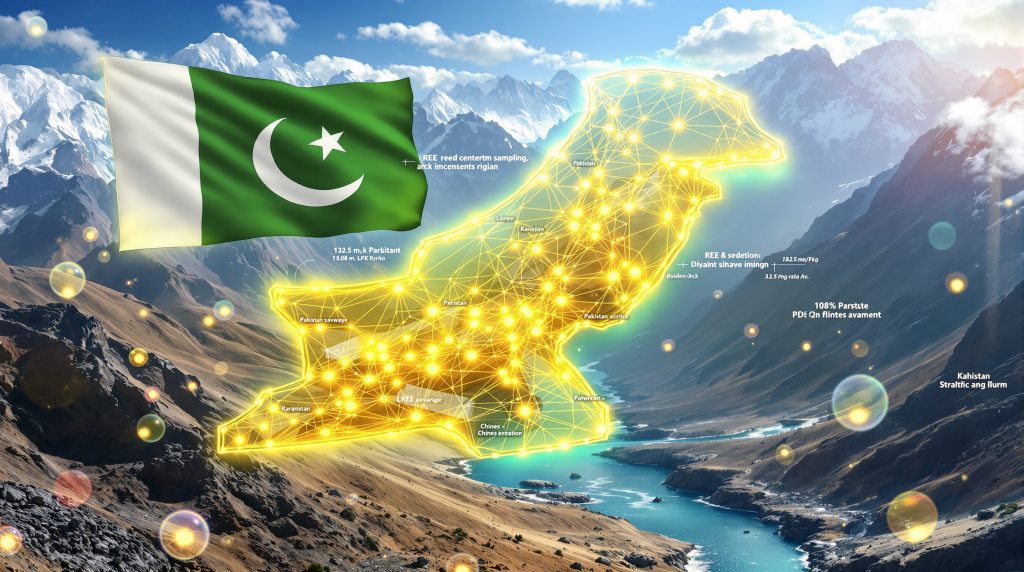Pakistan's inaugural national rare earth element map represents a groundbreaking achievement in geological surveying, covering an unprecedented 360,000 km² through meticulous stream sediment analysis. The comprehensive assessment employed a standardized 10 km × 10 km sampling grid, with research teams collecting over 4,400 samples systematically across the nation's diverse terrain. This systematic approach to critical minerals energy security provides Pakistan with crucial data for strategic mineral development.
Stream sediments were selected as the primary sampling medium because rare earth elements weather from host rocks at relatively slow rates and concentrate in predictable downstream patterns. Furthermore, this methodology offers several documented advantages for regional exploration programs whilst maintaining cost-effectiveness for national-scale analysis.
The systematic approach provides consistent data quality across Pakistan's varied geographical regions, from mountainous terrain to coastal plains. Additionally, stream systems naturally integrate geochemical signals from extensive upstream drainage basins, enabling broad spatial coverage with manageable logistics. This cost-effective exploration method requires significantly lower capital investment compared to systematic bedrock drilling programs while maintaining comprehensive territorial coverage.
Scientific Collaboration Framework
The mapping project emerged through bilateral cooperation between the China Geological Survey and Pakistan's Geological Survey, with additional support from academic institutions in both nations. This partnership combined Chinese technical expertise and funding with local geological knowledge and field operations experience.
According to research published in the Journal of Geochemical Exploration, the collaboration utilised China's National-scale Geochemical Survey of South and Central Asia framework. Consequently, this initiative extends Beijing's geological intelligence gathering across strategic partner nations while providing participating countries with comprehensive mineral resource assessments.
The 10 km × 10 km grid design ensures uniform spatial resolution across all physiographic regions, creating statistical robustness for anomaly detection and pattern recognition. In addition, this standardised methodology enables reproducibility for future monitoring studies and establishes a national-scale baseline for direct regional and international comparisons.
Northern Belt Geological Dominance
Pakistan's most promising rare earth territories cluster within three distinct geological formations that display exceptional REE concentrations reaching up to 1,403.1 mg/kg in peak anomalies. Moreover, these northern regions demonstrate significantly higher potential compared to central and southern areas, with advanced resource exploration techniques revealing substantial mineralisation patterns.
Himalayan Fold-and-Thrust Belt Analysis
The Himalayan system represents Pakistan's most REE-enriched geological region, displaying maximum concentrations of 1,403.1 mg/kg in stream sediment samples. This continental collision zone underwent compressive tectonism from the Cretaceous through present day, creating multiple mineralisation events and diverse rock types.
The prolonged tectonic history generated favourable conditions for REE concentration through several mechanisms:
• Metasomatic alteration around pegmatitic bodies that concentrate incompatible elements
• Hydrothermal circulation within faulted carbonate sequences during deformation
• Weathering and laterite development processes that naturally concentrate rare earth elements
• Complex fold-and-thrust structures that created diverse mineralisation environments
Karakoram Terrane Characteristics
The Karakoram represents an accreted microcontinent with significant igneous intrusive activity, showing REE concentrations ranging from 800-1,200 mg/kg in anomalous zones. This terrane displays pronounced light rare earth element enrichment consistent with the overall 3.08 LREE:HREE ratio identified across Pakistan's deposits.
The prevalence of light rare earth enrichment suggests mineralisation associated with granitic plutons emplaced during collision tectonics. Furthermore, carbonatite bodies typical of continental rift-related magmatism and pegmatitic dike systems that concentrate incompatible elements contribute to the elevated REE signatures observed in stream sediments.
Kohistan Island Arc Potential
The Kohistan volcanic and plutonic complex represents an ophiolitic island arc sequence that displays REE concentrations between 600-1,000 mg/kg. This accreted terrane preserves arc-related mineralisation processes, including fractional crystallisation of mafic magmas and subsequent concentration of REE-bearing phases.
Arc-related geological systems globally host significant rare earth deposits through processes involving:
• Magmatic differentiation that concentrates REEs in evolved melts
• Hydrothermal alteration zones associated with porphyry and skarn systems
• Contact metamorphism that mobilises and reconcentrates rare earth elements
| Geological Region | Maximum REE (mg/kg) | Average Range (mg/kg) | Primary Controls |
|---|---|---|---|
| Himalayan Fold-Thrust Belt | 1,403.1 | 200-800 | Tectonic complexity, multiple intrusions |
| Karakoram Terrane | 1,200 | 150-400 | Granitic plutons, carbonatites |
| Kohistan Island Arc | 1,000 | 100-300 | Arc magmatism, differentiation |
| Central Plains | 200 | 50-150 | Limited bedrock exposure |
| Southern Regions | 300 | 40-100 | Coastal influences, mixed geology |
Light Rare Earth Element Dominance
Pakistan's national rare earth element map reveals a pronounced enrichment in light rare earth elements, with a measured LREE to HREE ratio of 3.08:1. This geochemical signature indicates specific mineralisation processes and aligns with globally significant REE deposit types that demonstrate similar enrichment patterns.
What Makes Light REE Elements Critical for Industry?
The light rare earth dominance encompasses elements essential for modern industrial applications. Lanthanum and cerium typically constitute 60-70% of total REE content in LREE-enriched deposits, while neodymium and praseodymium represent the most economically valuable components for permanent magnet manufacturing.
Primary Light REE Components:
• Lanthanum applications: Catalytic converters, battery alloys, optical glass manufacturing
• Cerium utilisation: Polishing compounds, automotive catalysts, glass additives
• Neodymium demand: Permanent magnets for wind turbines, electric vehicles, electronics
• Praseodymium applications: High-strength magnets, aircraft alloys, glass colouring
The 3.08:1 LREE/HREE ratio directly correlates with carbonatite-hosted and alkaline igneous mineralisation patterns observed in major global REE operations. Consequently, this signature indicates Pakistan's deposits share geological characteristics with successful mining operations worldwide, including Mountain Pass in California and Bayan Obo in China.
Mineralisation Process Indicators
Light rare earth element enrichment in Pakistan's geological systems reflects specific formation processes that concentrate these elements preferentially over heavy rare earths. Crystal-liquid fractionation during fractional crystallisation of carbonate and alkaline melts creates conditions where LREE-enriched phases crystallise preferentially.
REE-carbonate complex formation in aqueous fluids enables LREE complexes to remain mobile in solution while heavy rare earth elements precipitate more readily. This geochemical behaviour explains the observed enrichment patterns and suggests underlying geological systems capable of concentrating economically significant REE grades.
"The dominance of light rare earth elements in Pakistan's deposits positions the country favourably for supplying global demand, as LREEs represent approximately 95% of total rare earth consumption by volume across industrial applications."
Strategic Partnership Implications
China's involvement in Pakistan's national rare earth element mapping extends beyond scientific collaboration, representing a strategic positioning within global supply chain dynamics. However, the project operates under China's National-scale Geochemical Survey of South and Central Asia initiative, providing Beijing with comprehensive geological intelligence across partner nations while advancing mining industry innovation methodologies.
Belt and Road Initiative Integration
The mapping project integrates seamlessly with China's Belt and Road Initiative objectives, extending geological surveying capabilities across strategic corridors. Chinese funding and technical expertise enable participating countries to access advanced geochemical assessment capabilities while building bilateral scientific relationships.
This collaboration provides China with several strategic advantages in global REE markets:
• Upstream resource knowledge acquired before competitive exploration commences
• Processing technology leverage through established refining capacity dominance
• Supply chain integration opportunities connecting new deposits with existing operations
• Geopolitical influence developed through resource development partnerships
Dependency Risk Assessment
Pakistan's REE development path presents both opportunities and strategic risks requiring careful policy consideration. Access to Chinese processing technology and capital enables rapid development timelines through established partnerships, while integration into global supply chains occurs via Chinese-controlled networks.
However, this partnership structure creates potential dependency relationships that may limit Pakistan's long-term strategic autonomy. Countries with significant REE resources but limited processing capabilities often become raw material exporters rather than value-added manufacturers, constraining economic benefits and industrial development opportunities.
The current global context intensifies these considerations, as China controls approximately 85-90% of REE refining capacity worldwide. Western nations actively seek alternative suppliers and processing capabilities, creating opportunities for Pakistan to diversify partnerships beyond Chinese-dominated networks.
Market Positioning and Economic Potential
Pakistan's rare earth discoveries emerge during a period of unprecedented global focus on supply chain diversification and critical raw materials supply security. Current market dynamics create favourable conditions for new suppliers entering established REE trade networks.
Global Supply Context
Worldwide REE demand totals approximately 160,000-180,000 tonnes of oxide equivalent annually, with light rare earth elements comprising 90-95% by mass. Pakistan's geological profile aligns directly with this demand structure, positioning the country favourably for commercial development within established frameworks.
Market Opportunity Analysis:
• Current supply concentration: China dominates 85-90% of global refining capacity
• Diversification pressure: Western nations prioritise alternative supplier development
• Strategic location advantage: Pakistan connects Asian and Middle Eastern markets efficiently
• Infrastructure potential: Existing mining operations provide adaptable foundation
Pakistan's potential market position could supply 5-10% of global LREE demand based on preliminary resource estimates. Furthermore, the country's strategic location enables efficient access to major consuming markets in Asia, Europe, and the Middle East through established trade corridors.
Investment Timeline Projections
REE development typically requires extensive lead times from discovery through commercial production. Pakistan's development pathway likely follows established international precedents for greenfield REE projects, with timelines reflecting global industry standards.
| Development Phase | Timeline | Key Activities | Investment Requirements |
|---|---|---|---|
| Exploration & Assessment | 2025-2027 | Detailed surveys, resource estimation | $50-100 million |
| Feasibility & Planning | 2028-2030 | Engineering studies, permitting | $100-200 million |
| Construction & Development | 2030-2033 | Infrastructure, processing facilities | $500M-1 billion |
| Commercial Production | 2033+ | Operations, market integration | Ongoing operational costs |
Development Challenges and Infrastructure Requirements
Pakistan faces significant obstacles in translating geological potential into commercial REE production. These challenges span technical, regulatory, and infrastructure domains requiring coordinated solutions and substantial investment commitments.
Processing Capability Gap
Pakistan currently lacks domestic rare earth separation and refining capacity, representing the most significant barrier to value-added production. Modern REE processing facilities require specialised equipment, technical expertise, and substantial capital investment to achieve commercial viability.
Critical Infrastructure Needs:
• Separation facilities: $500M-1B investment for modern REE processing plants
• Specialised equipment: Imports of solvent extraction and precipitation systems
• Technical expertise: Workforce training and international technology transfer
• Transportation networks: Enhanced logistics infrastructure for remote mining areas
Without domestic processing capabilities, Pakistan risks becoming a raw material exporter dependent on foreign refining capacity. This scenario limits economic benefits and strategic autonomy while creating vulnerability to supply chain disruptions and pricing pressures that could undermine long-term development goals.
Regulatory Framework Development
Pakistan requires comprehensive policy development to govern REE extraction and processing activities. Current mining regulations lack specific provisions for rare earth elements, creating uncertainty for potential investors and operators seeking clear operational guidelines.
Policy Development Priorities:
• Environmental protocols: Radioactive waste handling and water resource protection
• Foreign investment guidelines: Strategic mineral ownership and partnership structures
• Revenue sharing mechanisms: Community benefit and regional development frameworks
• Export licensing procedures: Strategic mineral trade controls and international agreements
The regulatory environment significantly influences investment decisions and project timelines. Clear, predictable policies enable faster development while protecting national interests and environmental resources from potential adverse impacts.
International Benchmarking and Competitive Analysis
Pakistan's rare earth potential requires evaluation within global supply chain contexts and competitive positioning relative to established and emerging suppliers. This analysis reveals the mineral discovery curve dynamics affecting international market positioning.
Global Reserve Comparison
International rare earth reserves provide context for Pakistan's potential market position. While Pakistan's resources remain under assessment, preliminary indicators suggest meaningful commercial potential within global supply frameworks that could significantly impact regional dynamics.
According to USGS geological survey data, global rare earth reserves and production capacities vary significantly between nations, with established producers maintaining substantial market advantages through integrated supply chains.
| Country | REE Reserves (million tonnes) | Annual Production (tonnes) | Processing Capacity |
|---|---|---|---|
| China | 44.0 | 140,000 | Complete supply chain |
| Australia | 4.2 | 25,000 | Limited processing |
| United States | 1.4 | 38,000 | Developing capacity |
| India | 6.9 | 3,000 | Partial processing |
| Pakistan | Under assessment | Potential 10,000+ | None currently |
Competitive Positioning Factors
Pakistan's geographical and economic characteristics create specific competitive advantages and challenges within global REE markets. Proximity to major Asian manufacturing centres reduces transportation costs and delivery times compared to distant suppliers operating across intercontinental distances.
Lower labour costs relative to developed nations provide economic advantages for labour-intensive separation and processing operations. Existing bilateral relationships with key consuming countries, particularly China and emerging relationships with Western nations, offer multiple partnership opportunities that could accelerate development timelines.
However, Pakistan's current lack of processing infrastructure and technical expertise creates dependency relationships that may limit strategic flexibility. Political stability concerns and security challenges in certain regions could impact investor confidence and operational continuity over extended development periods.
Strategic Development Pathways
Pakistan's rare earth development requires coordinated approaches addressing technical, regulatory, and strategic objectives. Multiple pathways exist for advancing from geological potential toward commercial production, each presenting distinct advantages and implementation challenges.
Government Policy Framework
Immediate policy priorities should establish foundational structures for REE sector development. Creating a National REE Development Authority would coordinate regulatory oversight, investment promotion, and strategic planning functions across multiple government departments and agencies.
Critical Government Actions:
• Regulatory clarity: Comprehensive REE mining and processing regulations
• Investment incentives: Tax structures and partnership frameworks attracting international capital
• Environmental standards: Sustainable development guidelines protecting natural resources
• Workforce development: Technical education and training programs building domestic expertise
Strategic initiatives spanning 2025-2027 should focus on detailed resource assessment programs, technology transfer negotiations, and processing facility planning. International marketing strategies and sales frameworks require development alongside technical capabilities to ensure market access upon production commencement.
Partnership Strategy Options
Pakistan faces strategic choices regarding international cooperation for REE development. Multiple partnership models offer distinct advantages and risk profiles requiring careful evaluation based on long-term national interests and immediate development needs.
Chinese Partnership Track:
- Access to established technology and processing expertise
- Rapid development timelines through existing supply chain integration
- Risk of dependency and limited strategic autonomy
Western Partnership Track:
- Alignment with supply chain diversification objectives
- Potential for technology transfer and capacity building support
- Longer development timelines and higher technical complexity
Hybrid Approach:
- Diversified partnerships balancing multiple strategic relationships
- Enhanced negotiating position through competitive options
- Complex coordination requirements across different technological standards
Private Sector Engagement
International exploration and mining companies represent essential partners for translating geological potential into commercial operations. Pakistan's REE sector requires significant foreign investment and technical expertise that domestic capabilities cannot currently provide through existing industrial infrastructure.
Investment Opportunity Categories:
• Exploration partnerships: Joint ventures for detailed resource assessment and development planning
• Processing facility development: Greenfield separation and refining plant construction
• Integrated supply chain projects: Comprehensive mine-to-market development programs
• Technology transfer agreements: Licensing and capability building for domestic processing development
"Pakistan's rare earth element mapping achievement represents both a scientific milestone and strategic opportunity, positioning the country at a critical juncture where geological potential must be balanced with development pathway choices that will shape decades of economic and geopolitical relationships."
The success of Pakistan's national rare earth element map in identifying significant mineral potential across diverse geological terrains demonstrates the value of systematic geochemical surveying. This foundational work provides the scientific basis for informed decision-making about resource development, international partnerships, and long-term strategic positioning within global supply chains.
Moving forward, Pakistan's challenge lies in converting geological knowledge into economic value while maintaining strategic autonomy and environmental stewardship. The choices made in the coming years regarding processing capabilities, partnership structures, and regulatory frameworks will determine whether Pakistan emerges as a strategic supplier or remains dependent on others for value-added production from its own mineral resources.
Want to Discover the Next Major Mineral Breakthrough?
Discovery Alert's proprietary Discovery IQ model delivers instant notifications on significant ASX mineral discoveries, transforming complex geological data into actionable investment insights before the broader market responds. Learn how historic discoveries have generated exceptional returns and begin your 30-day free trial today to position yourself ahead of emerging opportunities.




